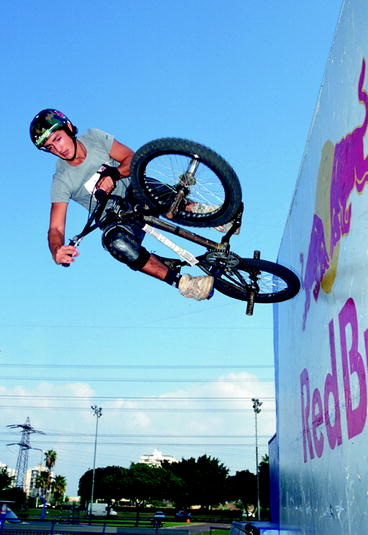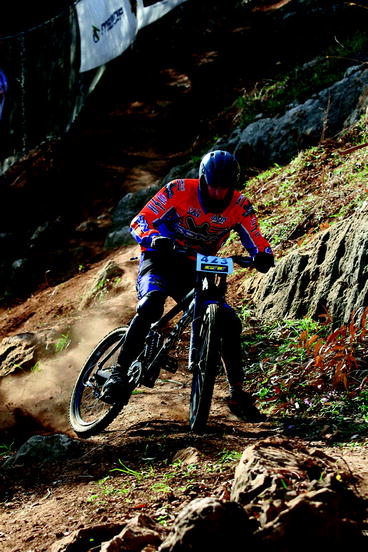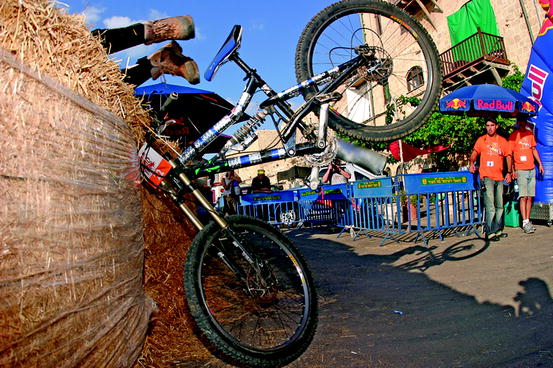Fig. 11.1
Downhill riding has slightly higher risk compared to cross-country (photo: Ronen Topelberg)

Fig. 11.2
The higher you jump, the further you fall (photo: Ronen Topelberg)
The modern downhill racing bike features technology more akin to that of off-road rally driving rather than the vision of the traditional mountain bike. Frames are built from carbon fiber, and both front and rear wheels use suspension systems in an effort to speed descents and increase energy efficiency [4–7]. Suspension systems provide significantly less muscular stress according to Seifert’s study [4] and lower power output from MacRae’s work [5] although have not shown this to be associated with a significant difference in VO2 max [5, 6]. Nishii found that over a test course, full suspension leads to an increase in cycling performance with faster cycling but decreased actual pedaling power [7]. The current vogue seems that downhill bikers tend to prefer full suspension systems, whereas there is increased use of hard tail or front suspension only for cross-country riders. The influence of bike weight is clearly a factor. A downhill full suspension bike weighs typically 15–17 kg, whereas cross-country models may weigh almost half this amount. The sport here is analogous to ski racing. Downhill riders use heavier bikes and take ski lifts to the top of their descent runs, whereas cross-country riders have lighter bikes as they will have to race uphill as well as down.
Mountain bike riding is also a popular recreational activity, occurring in both urban and rural surroundings by young and old alike. This chapter focuses on the injury demographics and specific injuries related to mountain bike riding and racing.
Injury Rates and Demographics
The reporting of mountain biking injuries commenced in parallel with sport development principally on the west coast of the United States during the 1990s. Initial questionnaire surveys of off-road bicycling organizations by Chow, Bracker, and Patrick had high response rates of 82.8 %. Eighty-four percent of respondents had been injured previously, and 51 % had injuries in the past year. Most injuries were minor; however, 26 % required professional medical care and 4.4 % required hospital admission. Ninety percent of injuries were abrasions, lacerations, and contusions, whereas 12 % sustained a fracture or dislocation, e.g., clavicle and shoulder. Frequent riding was associated with increased severity of injury, but most (87.6 %) occurred off paved roads. This survey suggested that compared to road cyclists, off-road cyclists had more frequent but not necessarily more severe injuries [8] (Table 11.1).
Table 11.1
Current literature mountain biking injuries
Ref. | Year of study | Type | Method | Control | Outcome | Additional data |
|---|---|---|---|---|---|---|
Chow et al. [8] | 1993 | Cross-sectional study | Questionnaire survey of bicycling club: injuries divided into mild versus moderate/severe | Mild: no hospitalization | MTB more frequent but not more severe injuries | Demographics |
Injury distribution | ||||||
Ride characteristics | ||||||
Krosnich and Rubin [10] | 1992 | Cross-sectional study | Questionnaire survey of 21 bicycling clubs | Injury: sought medical attention or unable ride for 1 day | 4× risk injury if competing | Most common: fracture, shoulder |
Loss control, high-speed descent, and competing main risk factors | ||||||
Pfeiffer [9] | 1992 | Cross-sectional survey of competing riders | Comparison of groups surveyed: 1991, 1992, and 1993 | No formal control group | Females more likely to get injured | Males more likely to sustain an injury during racing |
Injury is defined as one which forces the rider to stop and seek attention before returning to participation | Wounds most common injury | |||||
Knee most common area injured | ||||||
Rajapaske et al. [34] | 1992–1994 | Cohort study of forearm and wrist fractures in MTB riders | Questionnaire and clinical examination | MTB accidents can result in significant injury, majority do well, with minimum discomfort and no long-term physical and social consequences | Commonest injury undisplaced radial head fracture | |
Krosnich et al. [11] | 1994 | Cross-sectional study of riders at a single event. Mammoth Mountain, NORBA UCI | Injured riders were asked to complete a questionnaire and examined by a research physician | Injury was significant if occurred during competition and prevented the rider from completing the event. Injuries scored by Injury Severity Score | Injuries more severe when thrown from bicycle. Moderate injuries when thrown over the handlebars, minor injuries when thrown to the side. Most injuries occurred when going DH. Head-to-head events riskier | The small number of riders injured in a single event has limitations for the study |
Krosnich et al. [12] | 1995 | Case control series. Controls were the different groups of injured riders with respect to each condition | Riders sustaining injury at 3 off-road races completed questionnaires and exam | Injury rates 0.49 % for XC and 0.51 % for DH. 0.37 injuries/100-h racing in CC and 4.34/100 h in the DH | Riders falling over the handlebars had significantly higher injury severity scores and more emergency room visits | Risk of being injured in race is similar in both CC and DH. Greater severity of injury when fall forward over the handlebars. Female riders are more likely to fall forward than male riders and more likely to be injured |
Krosnich et al. [13] | 1994 | Cross-sectional study of riders at a single event. Mammoth Mountain | Injured riders completed a questionnaire interview and exam | Overall injury rate 0.40 %, 81.2 % injuries occurred while DH. Abrasions were the most common injury. Head-to-head riding riskier | Injury considered significant if occurred during competition and prevented the rider from completing that event | The small number of injuries that occur in 1 event may not reflect those that occur during a long sports season |
Rivara et al. [15] | 1992–1994 | Cross-sectional study | Questionnaire survey of those injured while riding off road | 3.7 % of cyclists injured were sustained cycling off road. Injury is defined as any rider who attends ED with their injury | Upper extremity and lower extremity were most likely to be injured. Abrasion was the most common injury | Majority of injuries minor. Off-road cyclists are less likely to have head injuries than other cyclists? Higher rate of helmet usage (4×) |
4 % cyclists had severe injuries (ISS > 8) | ||||||
Gassner et al. [26]. | 1991–1996 | Cross-sectional survey | Notes review and comparison of riders referred to Max. Fax. Dept. | Severe injury profiles of MTB riders compared to road cyclists. 15.2 % Le Fort fractures | Facial rather than jaw fractures | Recommend face guards for MTB riders |
Gassner et al. [27] | 1991–1996 | Cohort studies | Comparison between bicyclists and MTB riders. Review patient records | More severe injury profile with MTB riders | Increased face guard use together with helmets for MTB and bicycle riders | |
Grooten et al. [16] | 1997 | Cross-sectional survey | Mailed self-administered questionnaire survey to riders of Swedish XC World Cup | 75 % riders sustain a major or minor injury. 73 % riders sought medical treatment | Minor discomfort while riding, major injury prevents from riding. More training associated fewer injuries | Better-dosed training and the use of better equipment may prevent injuries |
Jeys et al. [17] | 1999 | Cross-sectional study | Notes review from patients seen in orthopedic fracture clinic | 23 % required op. treatment, most common injury: clavicle fracture | ||
Frauscher et al. [42] | Case control series | Ultrasound comparison of the scrotal contents of MTB riders compared with nonbikers | 94 % MTB riders had abnormal scrotal contents. 46 % had Hx of intermittent scrotal discomfort. Commonest: 81 % scrotal calculi, 46 % epididymal cysts | High prevalence of extratesticular and testicular disorders in MTB riders | ||
Quigley and Boyce [21] | 2004 | Cross-sectional survey | Questionnaire and notes review of riders attending A&E dept | Peak incidence in June. 8 % were admitted. Low speed, 65 % cases. 69 % XC. 21 % DH | ||
Gaulrapp et al. [18] | Cross-sectional survey of German magazine readership with >1 year experience off-road riding | Subscribers were randomly selected, subscribers who had not sustained an injury asked not to reply | Overall risk rate of 0.6 %/year and 1 injury/1,000-h riding | 75 % injuries were minor (pause in biking for <1 week), 10 % injuries were severe. | Uses the National Athletic Injury Reporting System | |
Commonest site: calf and knee. Commonest fracture: shoulder | ||||||
Chow and Krosnich [14] | 1994–1998 | Cross-sectional survey of those injured | Interview and exam of all riders competing at 7 off-road events. Mammoth Mountain 1994–1998, Vail and Mount Spokane in 1995 | Most injuries were minor and involved the extremities (70.5 %) | Falling over the handlebars results in injury more frequently than falling to the side, and injuries were more severe (ISS 3.4 vs. 1.7) | Falling over the handlebars produced more head and neck injuries, whereas falling to the side produced more lower limb injuries |
Kim et al. [19] | 1992–2002 | Cross-sectional study | Review of trauma registries entry requirements: presentation within 7 days injury, admission for ≥3 days, ISS > 12 and death | 3× increase in incidence of MTB injuries over 10-year period | Orthopedic injuries most common (46.5 %). 38 % of injuries and 66 % of patients required surgery | MTB is a growing cause of serious injuries |
Nelson and McKenzie [20] | 1994–2007 | Retrospective case series | Analysis of National Electronic Injury Surveillance System. | Rates of presentation decreased from 23,177 in 1995 to 10,267 in 2007 (P < 0.001) | The commonest injury: upper extremity 10.6 % and shoulder fractures 8.3 %. | More females were hospitalized 6.1 % compared to males 4.5 % |
Presentation with injury related to MTB | Those aged 14–19 more likely TBI | |||||
Aitken et al. [22] | 2011 | Cross-sectional study | Survey of those visiting a mountain biking area compared to those reporting injuries relating to MTB at surrounding ED | Overall injury rate found 1.54 injuries per 1,000 biker exposure | Males more commonly injured than females, particularly those aged 30–39. | |
Commonest injuries: wounds, skeletal fractures, and soft tissue injuries | ||||||
Lareau and McGinnis [50] | ?2009 | Cross-sectional study | 448 participants in cross-country (<6 h), 6–12-h races, and endurance races (>24 h) were surveyed | No increase in injury rate (7.2 %) in cross-country races < 6-h duration versus endurance races >6 h (4.7 %) (OR 1.6, 95 % CI) |
Pfeiffer surveyed the National Off-Road Bicycling Association (NORBA), a bicycle race series, by questionnaire, and Pro/Elite category in North America, in 1994, allowed further data collection, but response rates were initially poor (40 %), meaning that less firm conclusions can be made from these studies [9]. Wounds and bruises were the commonest type of injury reported, occurring in 58.1 and 68.2 % of males and female riders, respectively. Sprains, fractures, and dislocations occurred much less commonly. In males, the commonest regions injured were the knee (22.6 %) and the lower leg (12.3 %); however, in females, they were the lower back (16.5 %) and the knee (13.2 %). Typically, these are due to the rider falling to the side or putting out the leg in an attempt to slow down (Fig. 11.3). Already the sport was becoming more competitive with racers training for more than 10 h per week on an off-road bicycling. The majority of injuries (56 %) occurred during racing compared to training.


Fig. 11.3
Putting the foot down to the side tends to lead to less severe lower limb injuries, but misjudging a sharp turn and accidentally using the foot in order to stop or change directions can result in a major foot and ankle fracture (photo: Ronen Topelberg)
A questionnaire survey of the 1992 cycling season has been reported by Krosnich and Rubin. Injury rates were high with 85.7 % of respondents reporting injuries. Significant injuries were said to have occurred if the cyclist sought medical attention or was unable to ride on the following day. Ninety percent of these injuries were traumatic with fractures being the most common significant injury reported. The shoulder complex was the most commonly involved anatomical region. Loss of control, high-speed descent, and competitive activity were shown to be variables associated with traumatic injury. In this study, competitive activity level was the only independent risk factor positively associated with traumatic injury, with an adjusted odds ratio of 4.24 [10].
Reports from large mountain bike areas, e.g., Mammoth Mountain Ski Area in the United States, again by Krosnich et al., have revealed injury rates of 60 % for recreational riders; however, the majority of these were superficial injuries (65 %) not requiring medical treatment [11]. Riders that were involved in formal racing had injury rates of 0.39 %, and no differences in the severity of injuries were found between downhill and cross-country riders [11]. Significant injuries are considered to be those in which riders miss a day’s cycling, and 26 % of injuries in Krosnich and Rubin’s study met these criteria [10]. The commonest of these injuries were fractures, of which 57 % involved the upper extremity compared to 21 % the lower extremity. The acromioclavicular joint was the most commonly injured joint and the clavicle the most common fracture (40 %).
Further studies on the America NORBA series identified injury rates of 0.37 cyclists per 100 h cross-country racing and 4.34 per 100 h of downhill racing [12]. Turning was the commonest reported mechanism of injury, others being loss of control or traction and mechanical problems. Riders who fell forward over the handlebars sustained more severe injuries (Injury Severity Score [12] 3 vs. 1.3) (Fig. 11.4) and required more emergency department visits than those who fell to the side. Also, females were more likely to fall over the handlebars than male riders [12]. This is probably due to female riders being lighter than male. Falling over the handlebars produced more head and neck injuries than falling to the side (56 % vs. 8 %) and generally more severe injuries (with an Injury Severity Score of 3.4 vs. 1.7); conversely, falling to the side generally led to more lower extremity injuries (88 % vs. 57 %) [14]. Thus, female riders could be considered to be more prone to severe injuries.


Fig. 11.4
Falling over the handlebars tends to lead to more severe head, neck, and face injuries. Bikers in an urban event (a mountain bike competition within a city) are taking the corner too fast and crash into a thatch block (photo: Ronen Topelberg)
Other studies consider an injury to have occurred if a rider was unable to complete an event. It must be borne in mind that certainly in downhill events, riders are very “pumped up” and may complete events even with significant injuries, e.g., fractures, if they are mechanically able to ride. Questionnaire surveys may be more accurate than event-side medical care reporting as riders may note abrasions and contusions on a survey of recreational riders, but professional riders may not consider these to be significant enough injuries to trouble event medical support. Surveys may more accurately report a prolonged period of potential exposure compared to the duration of a single or series of events. The American studies tend to involve riders racing on dirt and gravel mountain roads at ski areas. Over other types of terrain, injury patterns may be different.
When injuries sustained during bicycling resulting in attendance at an emergency department were analyzed by Rivara, almost four percent of riders were injured off road. Of these, 73 % were 20–39 years of age and 88 % were males. Injuries were less severe, and riders required less hospitalization than road cyclists [15]. In this questionnaire study at the time of the crash, more off-road riders (80.3 %) wore helmets than other cyclists (49.5 %).
Research into mountain bike accidents has not been totally from the United States. When Swedish racers were surveyed by Grooten, 75 % reported having had an injury, and once again, the knees and lower back were most commonly affected, and 71 % reported minor injuries. Although not statistically significant, riders that trained more and had partaken preseason training sustained fewer injuries [16].
Some studies have reported on the seasonal variation of injuries. Within the United Kingdom, more off-road riders presented to an emergency department during the summer months, most commonly August. In Jey’s study, the commonest injury was a clavicle fracture, and alarmingly 23 % of injuries required operative intervention [17].
Stay updated, free articles. Join our Telegram channel

Full access? Get Clinical Tree








